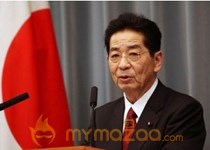Japan was currently facing its worst crisis since World War II, Prime Minister Naoto Kan said Sunday, as the toll from the earthquake and tsunami crossed the 1,000 mark and amid fears of a meltdown at a quake-damaged nuclear power plant.Radiation levels had surpassed the legal limits at the Fukushima I plant in north-eastern Japan, 240 km north of Tokyo, officials said Sunday, raising concerns over radiation leaks and a possible core meltdown.
After Japan’s most severe earthquake on record and in view of a looming nuclear catastrophe, Kan said the situation at the Fukushima plant “continues to be in an alarming state”, according to the Kyodo news agency.
Kan told reporters that more than 12,000 people had been rescued since Friday. But as local and international search-and-rescue teams continued their search for survivors, police said more than 1,000 bodies had been found.
The number of casualties from Friday’s earthquake, upgraded Sunday by Japanese authorities to 9.0 and which triggered a devastating tsunami, was expected to increase dramatically.
Takeuchi Naoto, the police chief of the hardest-hit prefecture of Miyagi, said he had “no doubt” the toll would rise above 10,000 in the prefecture alone, according to public broadcaster NHK.
The prime minister said that more than 600,000 people in the worst-hit areas had taken refuge in schools and community centres.
“In some places, we saw that houses and buildings had been completely destroyed,” Mikiko Dotsu,the coordinator of a team from Medecins Sans Frontieres, said after she arrived in Sendai near the quake’s epicentre.
She said 90 disaster medical assistance teams were deployed in Miyagi, of which Sendai is the capital.
“At the moment, there is very little electricity and no water supply,” Dotsu said. “People need food, blankets and water. These needs are bigger than medical needs at the moment.”
The USS Ronald Reagan aircraft carrier arrived off north-eastern Japan and began relief operations Sunday after being diverted from war games with South Korea.
The US Navy is to help transport food and people into the disaster area and helicopters on the aircraft carrier began airlifting food aid Sunday, Japan’s Defence Ministry said.
A municipal official in Futaba town in Fukushima prefecture told Kyodo news that about 90 percent of the houses in three coastal communities had been washed away by the tsunami.
Kan doubled the number of soldiers sent to the disaster areas to 100,000 as rescue workers were struggling to reach them as many roads were blocked by debris.
“I ask for utmost efforts to save the lives of as many people as possible,” Kyodo quoted Kan as saying after a meeting of the government’s emergency disaster headquarters. “We will put all-out efforts into rescuing people who have been isolated.”
Drinking water was transported to quake-hit regions by truck, and witnesses said residents were rushing to stock up on supplies at supermarkets and petrol stations, buying food and heating oil.
Railway links to the quake-hit regions are to remain closed, Japan Rail said, but it resumed operations in the Tokyo metropolitan area. Highways were also closed.







